|
|
The bees need to be able to maintain their warmth throughout the winter to survive. That means that they need to have a ready supply of carbohydrates available to them – without my having to open their brood boxes, and allowing their heat to escape from the hive. These “candies” are placed directly above the frames or above an inner-cover that has a hole to allow bee access to the area above the inner cover. A 2″-3″ tall box is added, with the outer cover going on top of that.
Here’s a recipe – provided to the BeeMaster’s Facebook group by Emil Kaluza – a beekeeper in South Texas.
Add 2 qts water to a 5 gallon stainless pot and 1 qt chamomile tea, steeped and cooled.Bring to boil.
When boiling add parts of 25lb bag of plain sugar, mixing as you do. Monitor heat, keeping as close to 230 degrees as possible, adding sugar as able. When all the sugar is added, stir constantly and boil at 230 degrees.
After a 10 minute boil at that temp, ad 1 teaspoon of Cream of Tartar. Remove from heat and let cool (this will take hours) to below 200 degrees.
Whisk or stir rapidly until it begins to whiten. Can be down to 150 degrees.
Pour into forms and let sit all night. They will harden, dry out, and whiten to a rock candy consistency and the bees will moisten and munch. Very easy and clean method of Winter feeding.
There are hundreds of fondant and bee candy recipes out there, but I’ve reduced mine to the basics, though you can add a pinch of salt with water(I do), or add a quarter cup of lemon juice (I don’t), or replace cream of tarter with 1 tsp of vinegar per pound of sugar ( I don’t, never had a problem with cream of tartar). You can add 5 lb of Soy Flour for protein if you don’t have much pollen in your hive. You can feed now as I do, but ants will be a problem until Winter, when its feed, close, forget, not having to open and lose heat from your hives until Feb.
It’s starting to cool off – and the beekeeping season is starting to wind down.
That does NOT imply, though, that we are done with the hive or honeybee work for the year. What’s there still to do, you may be asking yourself?
There’s lots! How about:
- Feeding for strong brood through the winter
- Manage the hives and combine any that are too weak to survive the winter with stronger hives
- Melting down and cleaning old wax into ingots
- Building and repairing swarm traps
- Making bottom-boards and hive covers
- Making new hive boxes for next years’ growth
- Making more honey supers for next years’ crop
- Making nuc boxes for spring 2013 splits/growth
- Assembling frames… assembling frames… assembling frames…
- Making wax foundation for the frames/hives
- Building pollen-catchers to harvest incoming local pollen
- Making hive-stands
The unfortunate truth, is that this growth and activity is paid for by the profits from the spring and summer honey flows. Please remember that when you buy local honey from your local beekeepers. Sometimes honey may seem expensive – but it’s really not when you consider all the work, equipment, labor, and education that is indeed part of the process to bring it to your table.
So – in addition to this work – I’m also still very active with performing honeybee removals from peoples’ homes. The spring and summer is really the best time to do this – however sometimes people need the bees to be re-homed NOW. I’ll perform that service for you – just call me for pricing and scheduling.
Hah! I received a call today from a gentleman that was referred to me by another beekeeper. He said that he had a lot of bees on the outside eve of his house – and that he’d had bees removed from a wall of his home about 3 weeks ago. I thought to myself – there may have been enough stragglers to cluster for a few weeks… I’ll go scoop ”em up and be on my way… No biggie.
When I arrived and evaluated the situation – It was a “holy crap” moment. The “cluster” was under the 2nd floor eve, and was about 2 feet long by about 8-10″ deep, and as wide as the eve (about 12″ at that spot). With that many bees – I knew they had drawn comb.
Whoever had performed the work before – assured them that he had removed the queen and all the bees. The homeowner’s family told me that the comb and bees had been “bagged up”. Eh? Bagged up? Really? Okay – so someone came and exterminated the bees.
Whatever the case – there was now 4 sizeable exterior combs built by the bees, and pollen and nectar had been stored in them. After removing a comb or two, I also saw that there were FRESHLY laid eggs. Less then 3 days old. There was a queen present.
I was going to bring a 5-frame nuc to put the bees in – but I felt a little tug of instinct telling me “bring a box or two”. I did. I brought 2 mediums – which wound up being perfect for this amount of bees. I was VERY happy that I’d brought the right boxes.
They are gentle bees – no sting attempts or bumping – and they now sit in the Richardson apiary. I’ll probably combine my “cluster” that was left from when I removed my other hives from the city, as they are already building comb. It would be good to combine them with the huge rescue from today.
In a land – not so far away, there lived a hive (or 8) of honeybees. These honeybees were known as “city bees”.
They were well-versed in finding the flowers, pollen and nectar that were planted around humans’ homes and parks. They visited trees, flower gardens, vegetable gardens and all sorts of city-places to find the nutrients that they needed to live healthy lives.
One day, a group of city politicians decided that they wanted to spray the entire city with poison to kill one specific kind of insect. (for those of you who are wondering – it was mosquitoes that were being sprayed for). The poison that they chose to use was one that really didn’t care whether it landed on a mosquito, a honeybee hive, or on flowers and plants that all pollinators and insects need to live healthy lives.
The keeper of the bees decided that the group of politicians were dangerous to a healthy and diverse environment – and that it was time to move the “city bees” out to meet and live with their cousins in the country.
The beekeeper waited til night-time, when most of the foragers had returned to their bee-hive homes, and closed the hive doors, and loaded the bee hives onto a trailer. That night the city bees took a trip to the country! This was a very exciting trip. At first they heard all their familiar city sounds of cars, planes, and regular city noises. Then as they drove away from the city – it got quieter. And quieter. And quieter.
Finally the truck and trailer stopped. It was still night time – but the headlights from the bee-keepers’ truck lit the new field in which the bees would live. The beekeeper put his beekeeping suit on, and started unloading and placing pallets for the honeybees’ homes to sit upon.
Finally – at about midnight, the honeybees homes were in their new locations, and the beekeeper opened up their doors.
The next morning, the honeybees had new smells to get used to. The smell of wildflowers, pine trees, mimosa trees, wild crape myrtle bushes, and HUGE gardens with all sorts of lovely flowers! Not to mention the little flowers that humans never notice on the rattan vines and the wild grapes and blackberries growing on the country fence-rows. I’m sure that the city-bees had never dreamed that such a place existed. Their cousins, the country bees had been here since earlier this spring – so they were able to show the newcomers where the best places were to get water, and for the best flowers from which to get pollen and nectar.

Here is a picture of the city-bees homes – all lined up in a row – at Harmony Hollow Apiaries – where they are joining their cousins to be “Country bees.”
I received a call for honeybees that were located in a home – near a local lake in a gated community. The home is about 25+ years old. Upon inspection – I determined that the bees were (luckily) located above the fascia board near the roof line. the variable being – how high into the attic-space did they continue to go?
These bees were very gentle. The only stings that I took were of my own account (accidentally squashing a bee, etc). My helper, though, took her first sting on this cutout. She’s helped me on several calls – but this one was the “magic one”. Here’s a few pics of the hive.
There were a LOT of bees pulled with this colony – but only about 4-5 combs of brood. The rest was capped and uncapped honey. This took approximately 8 hours total from start of inspection – til I buttoned up the home, added insulation to the void in the fascia space, and caulked with silicone to seal the entrances to the home.
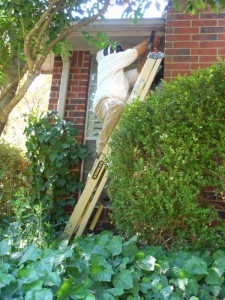 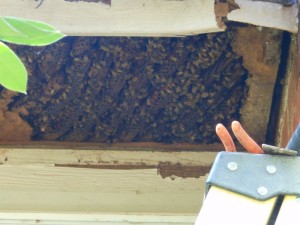 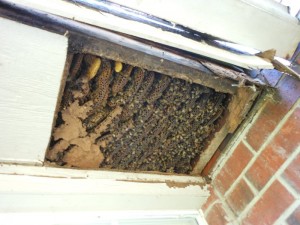 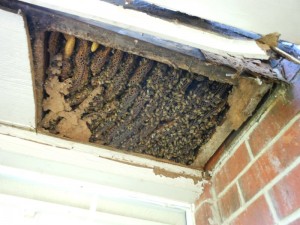
As if insult was not bad enough when they started spraying for West Nile Virus infected mosquitoes. Now Dallas County plans to move forward with aerial spraying of Dallas. That’s definitely adding injury to insult! (Yes – I know it’s backwards – but it’s how it is)
WNV is reported to give the same symptoms as the flu or a “summer cold” including fever. There are 9 (so far) reported “confirmed deaths” from WNV in Dallas county. In EACH of those cases – they have refused to give basic information about the deaths. What was the victim’s age? What other health issues did they have?
Well – What health issues are the “powers that be” going to spray onto us? they DON’T KNOW. They say “Bring your pets in, Stay Inside” and in the same sentence they proclaim that it’s “Safe”. Huh? Do you really think that we believe this line of dialogue?
Even the EPA recommends using spot control to eliminate mosquito larvae at the “local levels”. (See document here: http://www.epa.gov/pesticides/health/mosquitoes/mosquito.htm )
The EPA lists steps as:
- Surveilance
- Measures to Control Mosquitoes –
- The first method listed by the EPA is:Controlling mosquitoes at the larval stageLarvicides target larvae in the breeding habitat before they can mature into adult mosquitoes and disperse. Larvicides include:
Bacterial Insecticides
- Bacillus thuringiensis israelensis
- Bacillus sphaericus
Folks, please… Contact your local city representative and OPPOSE the blanket aerial spraying of YOUR city for West Nile Virus. It is my position that the people that do unfortunately succumb to the symptoms of the WNV – *really* have other underlying health issues that make them susceptible to an additional stress upon their body. We saw it with H1N1 (Swine Flu). The people that died and were confirmed as having been tested positive for H1N1 – ALREADY HAD MAJOR MEDICAL ISSUES THAT THEY WERE DEALING WITH. I have a close friend that had H1N1 at the time of his death. He also suffered from stage 3 emphysema. Who got the blame for the death, though? Piggie Flu.
What can YOU do to help?
- Be an EDUCATED resident. Ask pertinent questions (like: “WHAT is the chemical that will be sprayed?”, “What time of day will it be sprayed?”
- Research the active ingredient. See what it’s history is for human contamination. Does it cause birth defects or in ANY other way disable the human nervous system or body?
- Take action after you learn the answers. Contact your city rep. Contact your State Rep. – and voice your opinion. I highly recommend that it be an opposition to blanket spraying of a city. Also available are petitions that can be submitted to your city. Here’s one: http://www.change.org/petitions/dallas-stop-the-spray-combat-mosquitoes-the-intelligent-way
Folks – PLEASE – be an educated resident of your locale. CARE for your family and neighbors. Don’t let your city become a gas-chamber for a slow-release cancer than may not show up for years – or it may show up in the upcoming fetal generations.
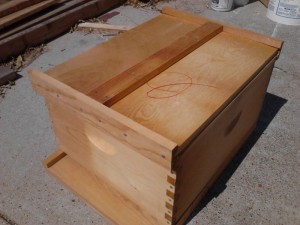 Shannon and I visited a Tyler area estate sale last weekend. I’d gone through the house – as well as the tool shed, and didn’t really see anything that caught my eye.. until we were leaving – I glanced down at a brown box.. that simply said “bee box” on it. Shannon and I visited a Tyler area estate sale last weekend. I’d gone through the house – as well as the tool shed, and didn’t really see anything that caught my eye.. until we were leaving – I glanced down at a brown box.. that simply said “bee box” on it.
Of course, my interest piqued, and I looked into the box. It was tagged at $20 – and this day happened to be a 25% off day. So – a $15 “bee box”. Upon further looking, this looks to be a vintage kit. Bottom board kit, a 10-frame deep, and a split lid with center-cleat. Also 10 deep frames. Take a looksee at the pictures, and see if you recognize who may have manufactured a kit like this. The wood is all cedar (and smells FANTASTIC!) – and the real thing that sets this box aside from any others is the top cover – with it’s strange end overhangs and the center-rail that covers the split between the two boards that create the top cover.
I assembled the kit today – and it’s 100% complete. But I’m still wondering who manufactured it, and what approximate year it would have been sold.
The instruction sheet was in the box – falling apart – but legible. I’ve taped it back together. There is no identifying brand on the instruction sheet either. BUT – The cardboard box has a stamped “624” on it – which I presume to be a stock number or a kit number.
Any ideas?
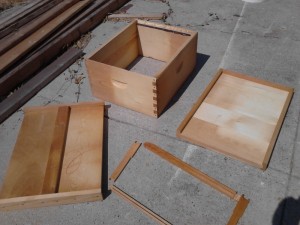
The trapout posted several days ago will not work. The bees have another entrance/exit about 10-15 feet in the air in the tree… There were no foragers from the bottom, because they were simply there for ventalation.
I’ll re-evaluate the tree later in the week, and see if I can close off the main entrance, so that the trapout can be effective.

Here are photos from a trap-out that was started this morning. These bees were VERY gentle. I believe that they have been here under 72 hours, and are still in comb-building mode – as there were NO foragers exiting & returning.
And a MORE clos  e up shot: e up shot:
Here is the trap-out setup: 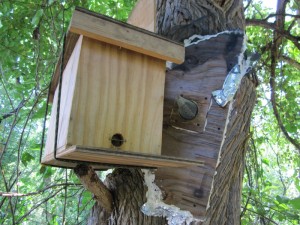
Another update for the work on the house:
7/25/2012
- Removed kitchen sink and countertop and back-splash
- Removed rotten wood (36+ years old home with particle-board cabinets that had gotten wet)
- Ordered cabinet hardware (hinges and pulls)
- Replaced all rotten wood on the cabinets
- Repaired my compressor
- Repaired water line after shooting a nail through it (don’t ask! I measured 2x for stud spacing!)
7/26/2012
- Finished replacing all cabinet wood that required it
- Started scraping cabinets of old paint
Only 6pm, and more painting prep to go for the evening.
|
|











